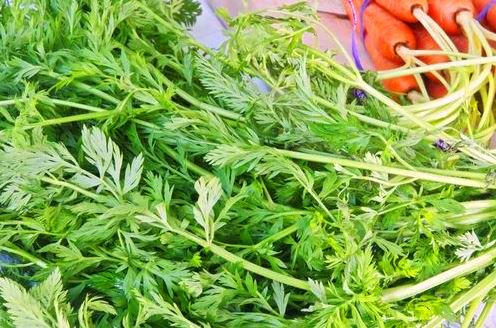My last job as a server was at a great rustic Italian restaurant. I soon saw just how resourceful the chefs were, making use of all the produce we had on hand. On many nights, our greens were none other than carrot tops or beet tops, sautéed with a little garlic and olive oil. Boy oh boy, the diners raved about our greens, asking me “what were those?” They were astonished to discover just how tasty carrot tops could be. They were pretty dern good in the soup too, always made of vegetable stock (made from produce scraps), beans, tomatoes and whatever other produce we had to make use of quickly before it went south on us.
Lesson learned—use as much of the vegetable as possible. Not only will you expand your world in terms of flavor and creativity, you’ll save a few bucks.
Edible Tops
The tops of carrots, radishes, beets, kohlrabi, turnips and just about any tuber or root vegetable are edible. If you want to cook them up in a jiffy, just rinse and sauté with a little olive oil and garlic. For tougher or older greens, cook in water or broth for 4-5 minutes, then sauté as described. Feeling more adventurous? Try stuffing them into a ravioli or making a fabulous carrot top pesto. You can also prepare the more leafy greens just the same way you’d do collards, in a pot with some bacon fat, onion, garlic and red pepper.
Not only will using the tops or greens that would have otherwise been thrown out stretch your budget, there’s lots of research going into looking at these greens for their unique nutritional content. Radish greens, for instance, have loads of calcium (20% RDA) per 3 ounce serving. And did you know all greens have protein? That’s right, that same 3 ounce serving has 2 grams protein and, 13% RDA iron, 280% RDA of vitamin A and a whopping 173% vitamin C. Plus, you’re getting vitamin K, magnesium and lots of those rare minerals everyone’s been talking about.
Cauliflower Leaves
Yup, they’re edible and, believe it or not, they’re delicious! Wash the leaves well and cut them diagonally, across the ribs then sauté with minced onion and garlic. The taste: like cabbage with a hint of cauliflower.
Potato Skins
The obvious thing to do with potato skins is to well, make potato skins with maybe a dollop or two of refried beans, sour cream and cheddar. Or, you can always make the most of their great, rough texture and make a rustic, flavorful plate of hash browns. All you have to do is slice or shred them diagonally. After that, dry them off with paper towels so they’re completely dry. For really full flavor, dice of a few stalks of green onions and have some strong cheese like parmigiano reggiano or extra sharp cheddar ready to go. Heat up 3 tablespoons peanut or canola oil, until shimmering. Toss in those shredded potato skins so they’re evenly dispersed in the pan. Don’t stack skins on top of skins. Fry until golden, about 3 minutes, and flip. Cook for one more minute then sprinkle on the green onions and cheese and fry until golden.
Or, make potato skin soup. That’s right, potato skins make a great soup. Puree them and along with some cooked onion, celery and carrot, then add some cream or milk and you’ve got one easy, tasty soup. Once you have this, you’ll see just how much flavor the skin of the potato imparts. And yes, the potato skin is better for you than the potato. It has more fiber, vitamin C and potassium than the flesh of the potato.
Bean Leaves
Chances are the only way you’ll see bean leaves is if you’re lucky enough to have a garden of your own. If you are oh so lucky, those limas, English peas, and snap peas all have edible leaves. My grandma was a fanatic gardener. Her summer salad consisted of blanched snap pea leaves and shelled peas with sautéed Vidalia onions and fresh, raw butter thrown in a bowl with butter leaf lettuce and raw sliced radishes, sliced thin as a razor. Add just a touch of black pepper and salt and well, that’s what heaven must taste like.
Banana Peels
Yes you can eat banana peels. In fact, in parts of Asia the banana peel is considered quite delicious. Nevertheless, since I personally find them a bit too ropey in texture to eat raw, I suggest trying them out the next time you grill or bake anything on a wooden plank. Making Jamaican jerk chicken? Place the banana peel underneath the chicken to help retain moisture. Sticky rice is great wrapped in banana peels and left to set in the refrigerator. Say that’s not exactly eating them? Well you’d be right. Full of nutrients, you can throw that whole, ripe banana, minus the stem, into your morning smoothie. Or, save the peel and divide it into 4-6 sections lengthwise and fry it up in a pan with peanut or canola oil until crispy (2-3 minutes). Top with honey and cinnamon.
Make banana tea. Though I haven’t tried it myself, banana tea is said to taste like a sweet black tea. All you have to do is bake the peels on a baking sheet at 150 degrees for one hour. Once cooled, crumble them up into small pieces. You can make tea by pouring hot water over the “banana leaf tea” and steeping for 2 minutes. If you want you can take one extra step and plop the banana tea leaves in a coffee grinder and then place the tea in a tea sieve.
More great info:
https://www.nytimes.com/2011/07/27/dining/thats-not-trash-thats-dinner.html?pagewanted=all&_r=0
https://www.livestrong.com/article/457082-what-are-the-benefits-of-eating-banana-peels/





